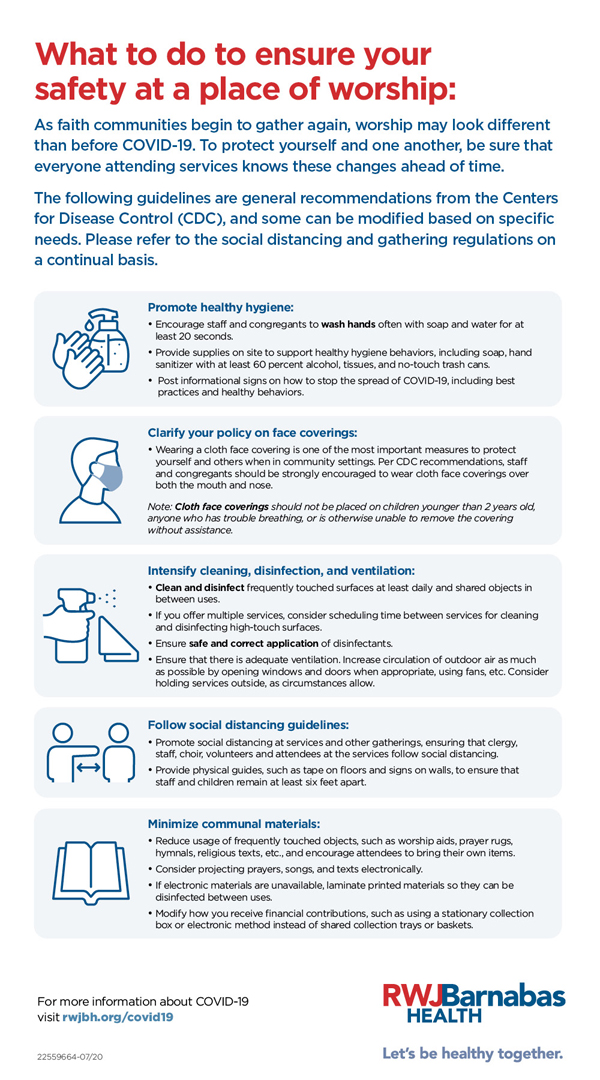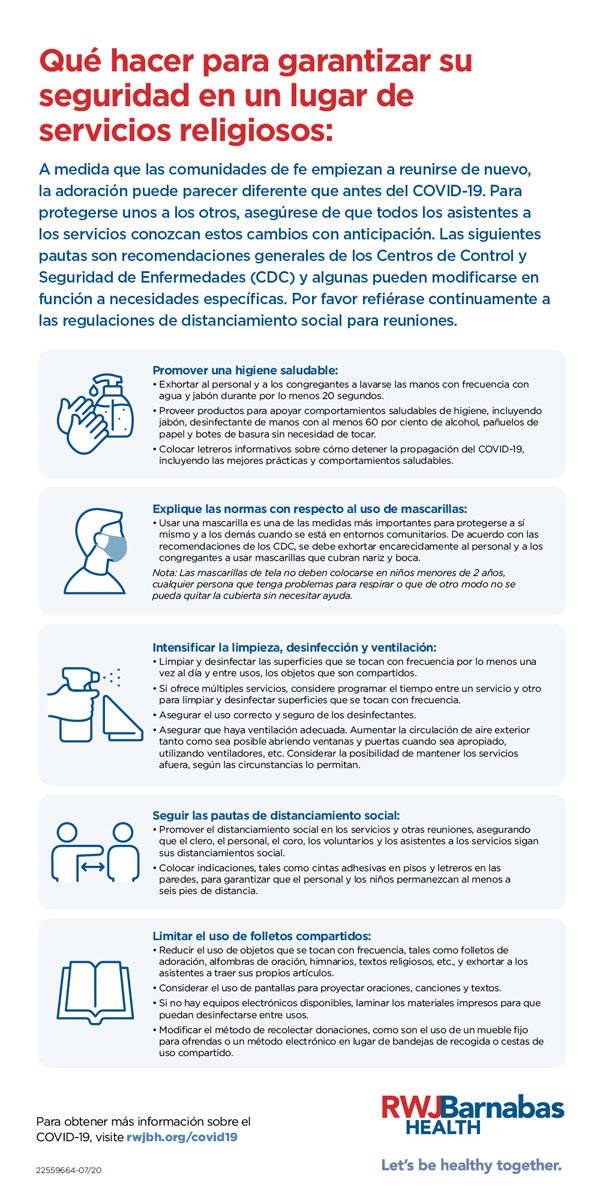What to do to Ensure your Safety in a Place of Worship
As faith communities begin to gather again, worship may look different than before COVID-19. To protect yourself and one another, be sure that everyone attending services knows these changes ahead of time.
The following guidelines are general recommendations from the Centers for Disease Control (CDC), and some can be modified based on specific needs. Please refer to the social distancing and gathering regulations on a continual basis.
Promote healthy hygiene:
- Encourage staff and congregants to wash hands often with soap and water for at least 20 seconds.
- Provide supplies on site to support healthy hygiene behaviors, including soap, hand sanitizer with at least 60 percent alcohol, tissues, and no-touch trash cans.
- Post informational signs on how to stop the spread of COVID-19, including best practices and healthy behaviors.
Clarify your policy on face coverings:
- Wearing a cloth face covering is one of the most important measures to protect yourself and others when in community settings. Per CDC recommendations, staff and congregants should be strongly encouraged to wear cloth face coverings over both the mouth and nose.
Note: Cloth face coverings should not be placed on children younger than 2 years old, anyone who has trouble breathing, or is otherwise unable to remove the covering without assistance.
Intensify cleaning, disinfection, and ventilation:
- Clean and disinfect frequently touched surfaces at least daily and shared objects in between uses.
- If you offer multiple services, consider scheduling time between services for cleaning and disinfecting high-touch surfaces.
- Ensure safe and correct application of disinfectants.
- Ensure that there is adequate ventilation. Increase circulation of outdoor air as much as possible by opening windows and doors when appropriate, using fans, etc. Consider holding services outside, as circumstances allow.
Follow social distancing guidelines:
- Promote social distancing at services and other gatherings, ensuring that clergy, staff, choir, volunteers and attendees at the services follow social distancing.
- Provide physical guides, such as tape on floors and signs on walls, to ensure that staff and children remain at least six feet apart.
Minimize communal materials:
- Reduce usage of frequently touched objects, such as worship aids, prayer rugs, hymnals, religious texts, etc., and encourage attendees to bring their own items.
- Consider projecting prayers, songs, and texts electronically.
- If electronic materials are unavailable, laminate printed materials so they can be disinfected between uses.
- Modify how you receive financial contributions, such as using a stationary collection box or electronic method instead of shared collection trays or baskets.
For more information about COVID-19 visit rwjbh.org/covid19
Qué hacer para garantizar su seguridad en un lugar de servicios religiosos
A medida que las comunidades de fe empiezan a reunirse de nuevo, la adoración puede parecer diferente que antes del COVID-19. Para protegerse unos a los otros, asegúrese de que todos los asistentes a los servicios conozcan estos cambios con anticipación.
Las siguientes pautas son recomendaciones generales de los Centros de Control y Seguridad de Enfermedades (CDC) y algunas pueden modificarse en función a necesidades específicas. Por favor refiérase continuamente a las regulaciones de distanciamiento social para reuniones.
Promover una higiene saludable:
- Exhortar al personal y a los congregantes a lavarse las manos con frecuencia con agua y jabón durante por lo menos 20 segundos.
- Proveer productos para apoyar comportamientos saludables de higiene, incluyendo jabón, desinfectante de manos con al menos 60 por ciento de alcohol, pañuelos de papel y botes de basura sin necesidad de tocar.
- Colocar letreros informativos sobre cómo detener la propagación del COVID-19, incluyendo las mejores prácticas y comportamientos saludables.
Explique las normas con respecto al uso de mascarillas:
- Usar una mascarilla es una de las medidas más importantes para protegerse a sí mismo y a losdemás cuando se está en entornos comunitarios. De acuerdo con las recomendaciones de los CDC, se debe exhortar encarecidamente al personal y a los congregantes a usar mascarillas que cubran nariz y boca.
Nota: Las mascarillas de tela no deben colocarse en niños menores de 2 años, cualquier persona que tenga problemas para respirar o que de otro modo no se pueda quitar la cubierta sin necesitar ayuda.
Intensificar la limpieza, desinfección y ventilación:
- Limpiar y desinfectar las superficies que se tocan con frecuencia por lo menos una vez al día y entre usos, los objetos que son compartidos.
- Si ofrece múltiples servicios, considere programar el tiempo entre un servicio y otro para limpiar y desinfectar superficies que se tocan con frecuencia.
- Asegurar el uso correcto y seguro de los desinfectantes.
- Asegurar que haya ventilación adecuada. Aumentar la circulación de aire exterior tanto como sea posible abriendo ventanas y puertas cuando sea apropiado, utilizando ventiladores, etc. Considerar la posibilidad de mantener los servicios afuera, según las circunstancias lo permitan.
Seguir las pautas de distanciamiento social:
- Promover el distanciamiento social en los servicios y otras reuniones, asegurando que el clero, el personal, el coro, los voluntarios y los asistentes a los servicios sigan sus distanciamientos social.
- Colocar indicaciones, tales como cintas adhesivas en pisos y letreros en las paredes, para garantizar que el personal y los niños permanezcan al menos a seis pies de distancia.
Limitar el uso de folletos compartidos:
- Reducir el uso de objetos que se tocan con frecuencia, tales como folletos de adoración, alfombras de oración, himnarios, textos religiosos, etc., y exhortar a los asistentes a traer sus propios artículos.
- Considerar el uso de pantallas para proyectar oraciones, canciones y textos.
- Si no hay equipos electrónicos disponibles, laminar los materiales impresos para que puedan desinfectarse entre usos.
- Modificar el método de recolectar donaciones, como son el uso de un mueble fijo para ofrendas o un método electrónico en lugar de bandejas de recogida o cestas de uso compartido.
Para obtener más información sobre el COVID-19, visite rwjbh.org/covid19
